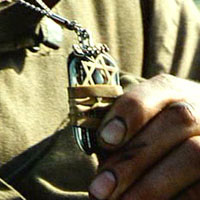
Office: HGH 210; phone: (408) 924-5378
Email: wooda@email.sjsu.edu
Web: http://www.sjsu.edu/faculty/wooda
 |
Dr. Andrew Wood Office: HGH 210; phone: (408) 924-5378 Email: wooda@email.sjsu.edu Web: http://www.sjsu.edu/faculty/wooda |
Ehrenhaus, P. (2001). Why we fought: Holocaust memory in Spielberg's Saving Private Ryan. Critical Studies in Media Communication, 18(3), 321-337.
Note: These comments are not designed to "summarize" the reading. Rather, they are available to highlight key ideas that will emerge in our classroom discussion. As always, it's best to read the original text to gain full value from the course.
Peter Ehrenhaus conducts a close
textual analysis of the Steven Spielberg film Saving Private Ryan (SPR),
studying the film as a response to declining American moral certainty. Here,
Ehrenhaus cites Susan Owen who argues that American
doubt makes it necessary (and difficult) to evoke a secular jeremiad:
“a call to a people to redeem themselves through a rededication to the
principles that define them as ‘a people’” (p. 332) -- particularly
if those principles are in doubt. Ehrenhaus finds that SPR works by employing
the Holocaust as justification for American involvement in World War Two, providing
a virtuous foundation from which future jeremiads might be crafted. To advance
this argument, Ehrenhaus begins by noting criticisms of Spielberg’s war
epic.
Initially, Ehrenhaus notes some left-leaning critics’ concerns that that
the film’s vivid description of war’s violence serves to romanticize
bloodshed. Here, we encounter Jean-Luc Godard’s claim
that even anti-war films are still pro-war. Ehrenhaus also notes right-leaning
critics who attack the film as unpatriotic. Of course, from other side, Ehrenhaus
finds that any criticism of SPR must be contextualized within the Vietnam
Syndrome: “The diminished capacity to suspend disbelief and to
engage discourses of national celebration” (p. 324). After all, if the
values embodied in the Vietnam War are suspect, how can subsequent war movies
(and wars) be any more worthy of trust? At this point, Ehrenhaus shifts to his
analysis of how SPR evokes the Holocaust as a means to elide the Vietnam Syndrome.
 Ehrenhaus
argues that SPR’s character, Private Mellish, provides the means for audiences
to experience an Americanization of the Holocaust. After providing
illustration of Mellish’s assimilation to American culture and his pride
in Jewish heritage, Ehrenhaus concentrates on the scene in which Mellish is
killed by a German soldier. Crucial to this scene is Corporal Upham, a frightened
soldier (a WASP, Ehrenhaus presumes) who fails to act while Mellish is killed:
“Woven into the fabric of this scene, viewers encounter one of the most
compelling reasons for the Americanization of the Holocaust memory -- guilt
for not having acted, for not having acted sooner, for not having done enough”
(p. 328). Thus, SPR reminds its viewers of America’s responsibilities
to act in the face of horror.
Ehrenhaus
argues that SPR’s character, Private Mellish, provides the means for audiences
to experience an Americanization of the Holocaust. After providing
illustration of Mellish’s assimilation to American culture and his pride
in Jewish heritage, Ehrenhaus concentrates on the scene in which Mellish is
killed by a German soldier. Crucial to this scene is Corporal Upham, a frightened
soldier (a WASP, Ehrenhaus presumes) who fails to act while Mellish is killed:
“Woven into the fabric of this scene, viewers encounter one of the most
compelling reasons for the Americanization of the Holocaust memory -- guilt
for not having acted, for not having acted sooner, for not having done enough”
(p. 328). Thus, SPR reminds its viewers of America’s responsibilities
to act in the face of horror.
To this analysis, Ehrenhaus emphasizes that the holocaust became an icon more
than a decade after World War Two, serving purposes beyond the need to identify
a particular history. The American symbolism of this icon, according to Ehrenhaus,
suggested that the state of Israel and the success of American Jewry could represent
the redemption of European Jews lost in the fires of the Holocaust. Afterward,
the author describes how the Holocaust became solidified as an unassailable
symbol from the 1960s through the 1980s, such that viewing a film like Schindler’s
List would become a “moral obligation of citizenship” (Cole,
cited in Ehrenhaus, p. 331). Ehrenhaus concludes with a question of whether
such moral certainty may carry the seeds of future regret.
[Return to Syllabus]